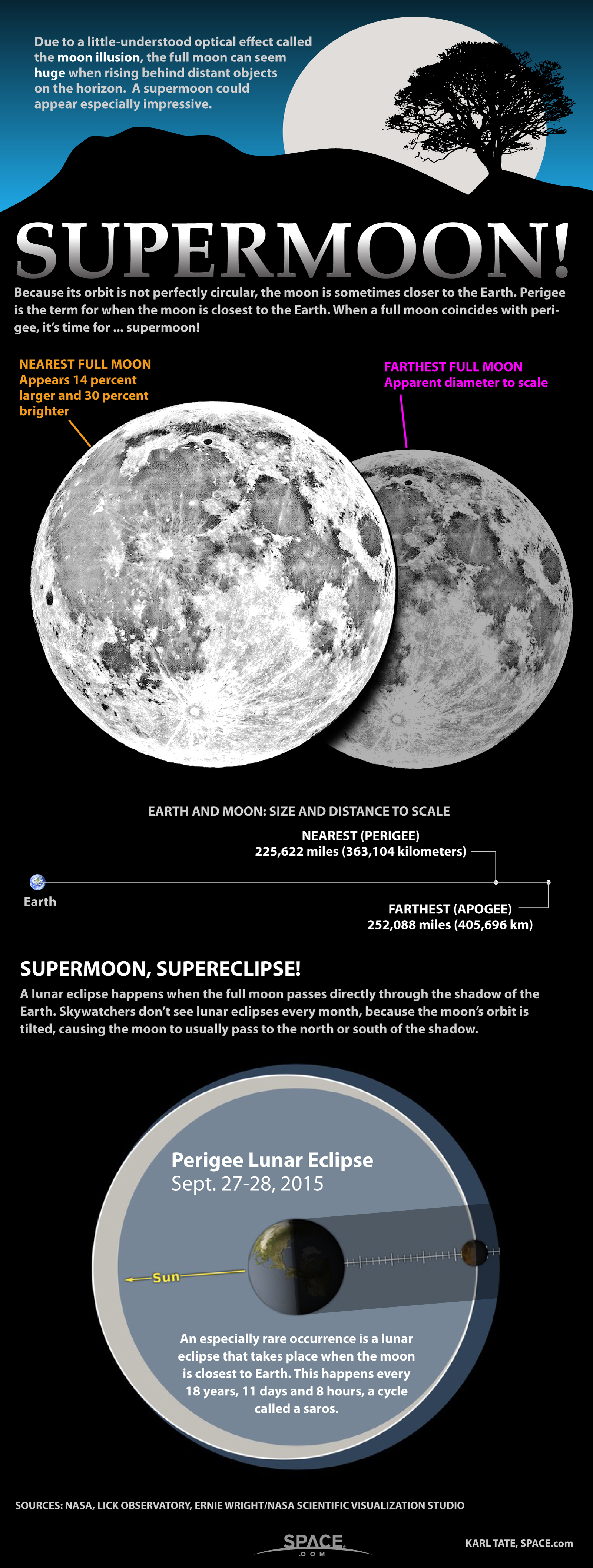What Makes a 'Supermoon' So Super?

Much ado has been made about the so-called "supermoon" that will take place tonight (March 19). Tonight's full moon will nearly coincide with the moon's arrival at the perigee point in its orbit around the Earth, resulting in the closest and biggest full moon in our sky since March 1993.
Or will it?
On Saturday night, the moon will arrive at perigee at 19:09 UT (3:09 p.m. Eastern Time). Its distance from the Earth at that moment will be 221,565 miles. But just over three years ago, on Dec. 12, 2008, which was also the night of a full moon, the moon reached perigee at 21:39 UT (4:39 p.m. Eastern Time) at a distance of 221,559 miles, about 6 miles closer than Saturday night's perigee distance.
So it seems Saturday night's supermoon will actually be just a little less super than the full moon of Dec. 2008.
Despite this fact, Geoff Chester of the United States Naval Observatory says tonight's full moon is still the winner for closeness of a full moon. How is that possible? [Photos: Our Changing Moon]
A lunar loophole
Chester points out that on Dec. 12, 2008, the moon reached fullness at 16:37 UT, while perigee was at 21:39. That's a difference of just over five hours. So when the moon turned full that night, it was still five hours away from reaching its closest point to Earth; its distance at the moment it turned full was 221,587 miles.
Breaking space news, the latest updates on rocket launches, skywatching events and more!
In contrast, today's full moon occurs at 18:10 UT, while perigee occurs at 19:09; the difference being less than an hour. So today, when the moon officially turns full, its distance from Earth will be 221,566 miles. [Video: 'Supermoon' Science of the Biggest Full Moons]
So even though the moon actually came a little closer to Earth in December 2008, if we compare distances when the moon officially turns full, today's full moon wins out by a scant 21 miles.
But for North Americans ... second place!
In all fairness, we should also point out that on Dec.12, 2008, the moment that the moon officially turned full was not visible in North America because it occurred during the daytime, when the moon was below the horizon.
And that very same circumstance will also occur at the moment today's moon turns full (2:10 p.m. Eastern Time; 11:10 a.m. Pacific Time); the moon will again be out of sight for North Americans. [Infographic: 'Supermoon' Full Moons Explained]
So back on Dec. 12, 2008 — as will be the case tonight — when millions of people cast their gaze toward the moon, it really wasn’t a "full" moon, but rather a waning gibbous moon. The same case will hold true tonight.
Certainly, to all of us who look up at it tonight's moon, it will appear "full," but keep in mind that the actual moment when the moon's disk became 100 percent illuminated will have already passed many hours earlier. Although not readily perceptible to most eyes, tonight’s moon will be waning or diminishing in illumination. Rather than seeing it fully illuminated, tonight we will see it at about 99.8 percent illumination).
Who's first?
In addition, the moon that North Americans will see with their own eyes tonight will actually run a very close second to that of Dec. 12, 2008, in terms of distance.
From Boston, for instance, when the moon comes over the eastern horizon this evening, it will be 221,580 miles away. [10 Things You Didn't Know About the Moon]
But on Dec. 12, 2008, at moonrise, Bostonians saw the moon ever-so-slightly closer, at 221,559 miles; again, just a scant 21 mile difference. That's because in 2008, the moon took more than five hours to reach its perigee point after it turned full. The moon was arriving at the closest point in its orbit just as darkness had begun to fall and the moon was beginning to appear over North America.
As Geoff Chester has already pointed out above, today's full moon and moment of perigee occur within less than an hour of each other, during the late morning/early afternoon hours for North America.
By the time darkness is falling and the moon begins appearing over the eastern horizon for North Americans, it will have already been slowly receding from Earth and so it will be a little farther away than it was in 2008.
But don't let all this stop you from going out tonight and enjoying the sight of this, the "biggest moon of 2011." The moon is, after all, our nearest neighbor in space, Earth's eternal companion and friend.
And let's face it ... what's 21 miles among friends?
Joe Rao serves as an instructor and guest lecturer at New York's Hayden Planetarium. He writes about astronomy for The New York Times and other publications, and he is also an on-camera meteorologist for News 12 Westchester, N.Y.

Joe Rao is Space.com's skywatching columnist, as well as a veteran meteorologist and eclipse chaser who also serves as an instructor and guest lecturer at New York's Hayden Planetarium. He writes about astronomy for Natural History magazine, Sky & Telescope and other publications. Joe is an 8-time Emmy-nominated meteorologist who served the Putnam Valley region of New York for over 21 years. You can find him on Twitter and YouTube tracking lunar and solar eclipses, meteor showers and more. To find out Joe's latest project, visit him on Twitter.

